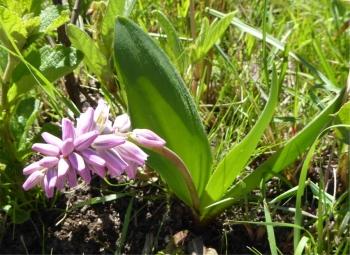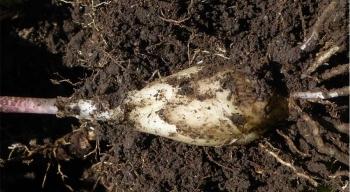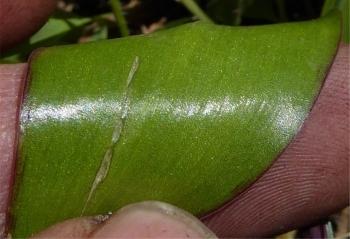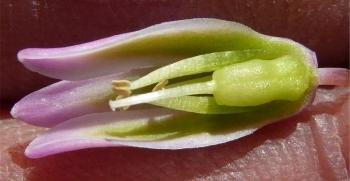Ledebouria lachenalioides
Ledebouria lachenalioides (Baker) J.C.Manning & Goldblatt
Family: Hyacinthaceae
Common names: pink African hyacinth
Introduction
A rare bulbous plant from high in the Drakensberg, with broadly lanceolate, green leaves and large, pink flowers in spring.

Description
Description
Small bulbous plant, usually solitary or forming small groups. The whitish bulb, 50 mm long and 35 mm wide, like members of the section Resnova, does not possess a tunic, which is commonly seen in the section Ledebouria, bulbs are naked with the bulb scales truncated.

Leaves, usually 2, broadly lanceolate, produced in early summer, can be up to 120 mm long and 35 mm wide, stalkless or occasionally with a short pseudopetiole (false leaf stalk), usually only produced in response to low light or thick vegetation. The leaves are light green and variously marked with spots, blotches or banding towards the base, or immaculate. The upper surface is dull and covered with sparse, erect hairs, sometimes hairs are arranged in broken longitudinal rows. The underside of the leaf is smooth, hairless and usually green to pinkish green or green with purplish, banding patterns towards the base.

Flowers are produced in early spring (September to October). Each bulb produces a solitary, elongated inflorescence, which can be up to 200 mm long, initially erect, soon becoming floppy as the fruits develop. Numerous, loosely arranged, bell-shaped, pinkish-purple and whitish striped, nodding flowers (florets) are presented on a green flower stalk. Each floret is comprised of 6 elongated pink tepals (petals), and is attached by a short pedicel (floret stalk). Typical of the section Resnova the flowers are unscented and the tepals only open apically creating a bell-shaped flower.

Conservation Status
Status
This species is not threatened, it is assessed as Least Concern (LC) in the Red List of South African plants.

Distribution and habitat
Distribution description
Ledebouria lachenalioides occurs at high altitudes in the Eastern Cape and Kwa-Zulu Natal Drakensberg where it occurs in short grassland and receives a high annual rainfall and constant cool conditions, and it prefers a humus-rich, loamy soil. It is endemic to South Africa.

Derivation of name and historical aspects
History
This species was first named as Scilla lachenalioides by Baker in 1847, from a specimen collected by Baur on the Bazeia Mountain in Eastern Cape. It was transferred to the genus Resnova by F.Z. van der Merwe in 1946. It was then moved to the genus Drimiopsis by Jessop in 1972, when he included the genus Resnova under Drimiopsis. In 1997 U. & D. Müller-Doblies resurrected the genus Resnova and the species once again found itself in that genus. Subsequently the genus Resnova was combined into Ledebouria in 2004 by Prof. John Manning, who, in 2012, also created two sections in Ledebouria to accommodate the closely allied groups (section Drimiopsis and section Resnova) that were formerly recognised as separate genera, which is where this species is classified currently. The specific epithet means ‘resembling the genus Lachenalia’.
The genus Ledebouria is named in honour of the German-Estonian botanist, Professor Carl Friedrich von Ledebour (1785–1851). South Africa has 61 species of Ledebouria, with several more species occurring across southern, western, eastern and northeast Africa and into India. The genus Ledebouria is a member of the Hyacinth Family and is well represented, especially across the eastern, summer rainfall parts of South Africa. Ledebouria lachenalioides is most closely related to L. pilosa, from which it differs by the larger pink flowers, which are the largest flowers in the section, and indeed in the entire genus.

Ecology
Ecology
The floral morphology of this species differs from the rest of the section in that the flowers are much longer and more elliptical (narrowing towards the apex). It is not understood why the flowers of this species differ so markedly from all other members of the section Resnova, it may have something to do with pollination. Species in this section typically have bell-shaped flowers which spread open apically, creating a deep bell-shaped flower, however in this species the apex of the flowers do not open as conspicuously as the rest of the section and the flowers are much larger and much longer. These differences may have some influence over the type or size of pollinator responsible for pollination; this aspect of the ecology of the species needs more research. After pollination the swollen, green, seed capsules develop rapidly, releasing matt brown, wrinkled seeds that are released by the bursting and shriveling seed capsule. There is very little known about the ecology of the species.
Uses
Use
There is no record of this species being utilized locally by humans.

Growing Ledebouria lachenalioides
Grow
This species is difficult to maintain in cultivation, it typically grows and flowers for a few years but becomes weaker and weaker until it disappears.
The bulbs prefer a humic-rich, peaty loam potting soil with sand added to provide a moist, acidic, well-drained base. They should be kept in morning sun to semi-shade and watered generously between rain showers in the summer growing season; water quality may play and important role. During the dormant period in winter, the containers should be allowed to dry out, with only an occasional light surface watering to maintain some soil humidity. The emergence of the flowers in spring usually coincides with the emergence of the leaves, at which time full watering can recommence.
Propagation of this species is most successful from fresh seed, sown in summer. Seed can be sown directly into pots or trays filled with the sifted growing mixture and pressed lightly. The seed can be covered with a thin, 3 mm, layer of fine sand or the same sifted potting mix. Germination is quick and can occur between 3-4 weeks. Seedlings can be left in their natal containers for up to 3 years or until they become too congested and then should be planted out in small clusters or as individuals into pots. Seedlings are susceptible to mealy bug below soil level, which can be treated using a systemic insecticide; damping off can occur during early establishment of the seedlings and precautions should be implemented in the form of a systemic fungicide.
References
- Baker. 1896-7. Scilla lachenalioides. Flora Capensis Vol 6: 482.
- Hankey, A. 2003. Distinguishing between Ledebouria, Drimiopsis and Resnova. PlantLife (S. Afr.) 29: 38, 39.
- Hankey, A.J. 2019. Proposed English common names for African hyacinths (genus Ledebouria). Plantlife SA, Vol 47:7 https://plantlifesouthafrica.blogspot.com/
- Manning, J.C., Goldblatt, P. & Fay, M.F. 2004. A revised generic synopsis of Hyacinthaceae in sub-Saharan Africa, based on molecular evidence, including new combinations and the new tribe Pseudoprospereae. Edinburgh Journal of Botany 60: 533–568.
- Manning, J.C. & Goldblatt, P. 2012. Hyacinthaceae. New combinations in Ledebouria. Bothalia 42 (1): 47–48.
- Raimondo, D., Von Staden, L., Foden, W., Victor, J.E., Helme, N.A., Turner, R.C., Kamundi, D.A. & Manyama, P.A. (eds) 2009. Red list of South African plants. Strelitzia 25. South African National Biodiversity Institute, Pretoria.
- Van der Merwe, F.Z. 1941. Scilla lachenalioides. Flowering Plants of South Africa Vol. XXI Pl. 824.
- Van der Merwe, F.Z. 1946. Aantekenige vir die hersiening van die genus Scilla L. in Suid-Afrika. Tydskrif vir Wetenskap en Kuns 6(3):46.
- Wikipedia. Carl Friedrich von Ledebour. http://en.wikipedia.org/wiki/Carl_Friedrich_von_Ledebour. Accessed 6 November 2018.
Credits
Andrew Hankey
Walter Sisulu National Botanical Garden
June 2022
Plant Attributes:
Plant Type: Bulb
SA Distribution: Eastern Cape, KwaZulu-Natal
Soil type: Loam
Flowering season: Spring
PH: Acid
Flower colour: Purple, White, Pink
Aspect: Full Sun, Morning Sun (Semi Shade)
Gardening skill: Challenging
Special Features:
Horticultural zones







Rate this article
Article well written and informative
Rate this plant
Is this an interesting plant?
Login to add your Comment
Back to topNot registered yet? Click here to register.